“This animal in
truth signifies God;
Know that the virgin signifies St Mary;
By her breast we understand similarly Holy Church;
And then by the kiss it ought to signify,
That a man when he sleeps is in semblance of
death;
God slept as man, who suffered death on the
cross,
And his destruction was our redemption,
And his labour our repose,
Thus God deceived the Devil by a proper semblance;
Soul and body were one, so was God and man,
And this is the signification of an animal of
that description."[1]
[1] Popular Treatises on Science written during the Middle Ages in Anglo-Saxon, Anglo-Norman, and English, ed. by THOMAS WRIGHT (Historical Society of Science, 1841), pp. 81-82.
This being the current belief concerning the symbolism of the unicorn in the Middle Ages, it is not surprising to find this animal utilised in church architecture; for an example see fig. 35.
The belief in the existence of these fabulous beasts may very probably have been due to the materialising of what were originally nothing more than mere arbitrary symbols, as I have already suggested of the phoenix.[1] Thus the account of the mantichora may, as BOSTOCK has suggested, very well be a description of certain hieroglyphic figures, examples of which are still to be found in the ruins of Assyrian and Persian cities. This explanation seems, on the whole, more likely than the alternative hypothesis that such beliefs were due to mal-observation; though that, no doubt, helped in their formation.
[1] “Superstitions concerning Birds.”
It may be questioned, however, whether the architects and preachers of the Middle Ages altogether believed in the strange fables of the Bestiaries. As Mr COLLINS says in reply to this question: “Probably they were credulous enough. But, on the whole, we may say that the truth of the story was just what they did not trouble about, any more than some clergymen are particular about the absolute truth of the stories they tell children from the pulpit. The application, the lesson, is the thing!” With their desire to interpret Nature spiritually, we ought, I think, to sympathise. But there was one truth they had yet to learn, namely, that in order to interpret Nature spiritually, it is necessary first to understand her aright in her literal sense.
IX
THE QUEST OF THE PHILOSOPHER’S STONE
THE need of unity is a primary need of human thought. Behind the varied multiplicity of the world of phenomena, primitive man, as I have indicated on a preceding excursion, begins to seek, more or less consciously, for that Unity which alone is Real. And this statement not only applies to the first dim gropings of the primitive human mind, but sums up almost the whole of science and philosophy; for almost all science and philosophy is explicitly or implicitly a search




